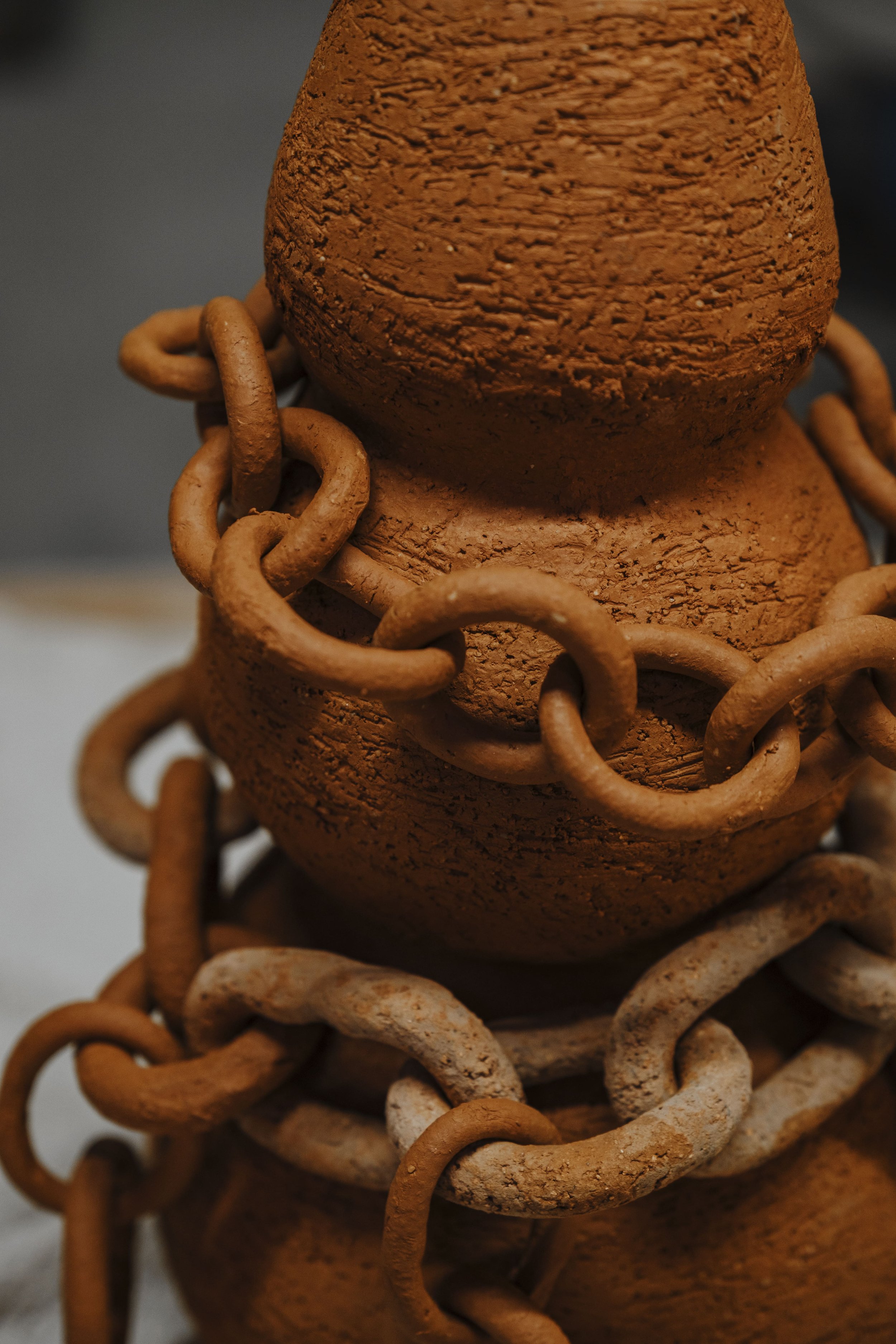Lillith in chains
"a hot fiery female who first cohabited with man"
Leviticus 19
The vessel is crafted from unglazed terracotta, emphasizing a raw, earthy texture that connects to the ancient myth of Lilith being made from the same clay as Adam. This material choice not only reflects the origins of Lilith but also her intrinsic connection to the earth and primal nature.
Form and Symbolism:
Feminine Form: The vessel’s shape is distinctly feminine, with curves that suggest the silhouette of a woman. This form is both a nod to Lilith's identity as the first woman and a representation of her strength and independence.
Chains: Surrounding the vessel are terracotta chains, also unglazed, symbolizing Lilith's story of being bound by societal expectations and constraints but also her resistance and defiance against them. The chains are free-moving, allowing interaction, which could symbolize the struggle between freedom and confinement, choice and constraint. They are an invitation to explore the dual nature of Lilith: a being both bound and free, constrained by societal norms yet rebellious and independent.
Cultural Context and Mythology:
Lilith, often depicted as a "hot fiery female," is known across various cultures and mythologies. She is a figure of both defiance and seduction, depicted as a demon in some traditions but also as a symbol of female empowerment and autonomy. She was believed to have been Adam's first wife, created from the same clay but banished for refusing to be subservient. This narrative sets her up as a complex figure — a shadow to Eve, embodying what is suppressed or feared in feminine power.
Interpretation and Use:
The vessel serves as a functional art piece, not only carrying the aesthetic and symbolic weight of Lilith's story but also inviting the user to engage with it. The chains can be manipulated, perhaps making a soft clinking sound, reminding the user of the ever-present tension between freedom and captivity, strength and vulnerability.
This piece could be used in various settings, from a contemplative art installation to a functional object in a ritual or spiritual practice, always evoking reflection on themes of power, independence, and the ancient stories that still shape our understanding of gender and rebellion.
"a hot fiery female who first cohabited with man"
Leviticus 19
The vessel is crafted from unglazed terracotta, emphasizing a raw, earthy texture that connects to the ancient myth of Lilith being made from the same clay as Adam. This material choice not only reflects the origins of Lilith but also her intrinsic connection to the earth and primal nature.
Form and Symbolism:
Feminine Form: The vessel’s shape is distinctly feminine, with curves that suggest the silhouette of a woman. This form is both a nod to Lilith's identity as the first woman and a representation of her strength and independence.
Chains: Surrounding the vessel are terracotta chains, also unglazed, symbolizing Lilith's story of being bound by societal expectations and constraints but also her resistance and defiance against them. The chains are free-moving, allowing interaction, which could symbolize the struggle between freedom and confinement, choice and constraint. They are an invitation to explore the dual nature of Lilith: a being both bound and free, constrained by societal norms yet rebellious and independent.
Cultural Context and Mythology:
Lilith, often depicted as a "hot fiery female," is known across various cultures and mythologies. She is a figure of both defiance and seduction, depicted as a demon in some traditions but also as a symbol of female empowerment and autonomy. She was believed to have been Adam's first wife, created from the same clay but banished for refusing to be subservient. This narrative sets her up as a complex figure — a shadow to Eve, embodying what is suppressed or feared in feminine power.
Interpretation and Use:
The vessel serves as a functional art piece, not only carrying the aesthetic and symbolic weight of Lilith's story but also inviting the user to engage with it. The chains can be manipulated, perhaps making a soft clinking sound, reminding the user of the ever-present tension between freedom and captivity, strength and vulnerability.
This piece could be used in various settings, from a contemplative art installation to a functional object in a ritual or spiritual practice, always evoking reflection on themes of power, independence, and the ancient stories that still shape our understanding of gender and rebellion.
Dimensions


